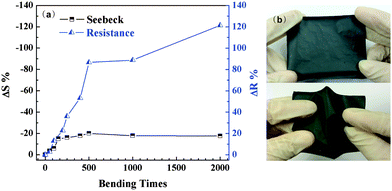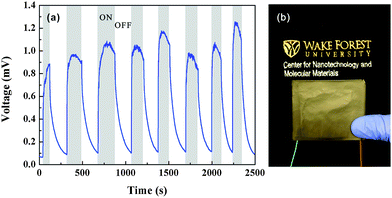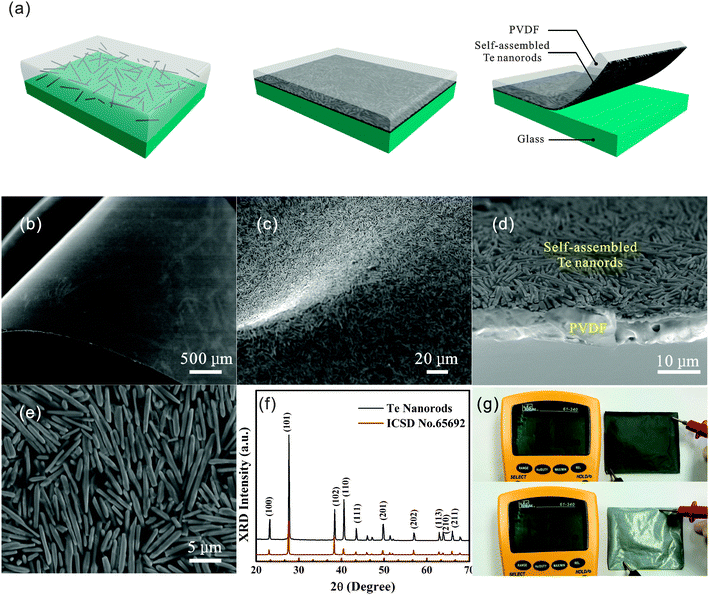Flexible thermoelectric fabrics based on self-assembled tellurium nanorods with a large power factor†
Chaochao
Dun
a,
Corey A.
Hewitt
a,
Huihui
Huang
*ab,
David S.
Montgomery
a,
Junwei
Xu
a and
David L.
Carroll
*a
aCenter for Nanotechnology and Molecular Materials, Department of Physics, Wake Forest University, Winston-Salem, NC 27109, USA. E-mail: huangh@wfu.edu; carroldl@wfu.edu
bSZU-NUS Collaborative Innovation Center for Optoelectronic Science & Technology, Key Laboratory of Optoelectronic Devices and Systems of Ministry of Education and Guangdong Province, College of Optoelectronic Engineering, Shenzhen University, Shenzhen 518060, China
First published on 6th January 2015
Abstract
Highly-flexible thermoelectric fabrics were fabricated based on a layered structure, composed of a thin active layer of self-assembled tellurium nanorods and a substrate layer of polyvinylidene fluoride. The resulting thermoelectric fabrics show a high room temperature power factor of 45.8 μW m−1 K−2, which opens a new avenue to fabricate highly-flexible sustainable energy sources.
Nowadays, the large proliferation of portable/wearable electronic devices stimulates research interests in lightweight and highly-flexible renewable and sustainable energy sources like solar cells, piezoelectrics, and thermoelectrics.1–4 Among them, thermoelectrics provide the unique capability to directly convert heat to electricity, which have the potential to continuously convert body heat into electrical power that could charge the portable/wearable electronic devices. Therefore, the pursuit of high performance flexible thermoelectric power sources is becoming one of the most interesting research fields.
The selection of materials is essential to fabricate high performance and flexible thermoelectrics. Thermoelectric performance of these materials is usually described by the thermoelectric figure of merit, ZT = α2σT/κ, where α, σ, T, and κ are the Seebeck coefficient, electrical conductivity, absolute temperature, and thermal conductivity, respectively. By considering the flexible nature of the materials, conductive polymers are thought to be an ideal choice to fabricate highly flexible thermoelectric devices due to the flexible nature and the low thermal conductivity of the polymer;7,8 however, most of the conductive polymers like poly(3,4-ethylenedioxythiophene):polystyrene sulfonate (PEDOT:PSS) and poly(3-hexylthiophene-2,5-diyl) (P3HT) are expensive and usually require complex treatments to achieve high electrical conductivity.9,10 Another alternative choice for fabricating flexible thermoelectrics is the use of composite materials including conductive nanowires–nanorods and polymers such as carbon nanotube–polymer composites.11–15 In this case, the carrier transport channel of these materials can be formed by the percolation pathway of the conductive nanostructures, so some cheaper insulating polymers like polyvinylidene fluoride (PVDF) could be selected as the flexible matrix of the composite.16 However, there is a tradeoff between the electrical conductivity and the flexibility of the composite films. Supposing the nanowires–nanorods are uniformly dispersed in the polymer matrix, in order to get good electrical conductivity, the volume amount of the nanowires–nanorods needs to be high enough to achieve the effective percolation threshold. Conversely, the higher the nanowire–nanorod concentration, the more brittle and less flexible the composite film becomes.12
In this paper, we use a layered structure to circumvent the dilemma between electrical conductivity and flexibility. The layered structure of the composite is formed by a thin self-assembled inorganic nanorod network layer below the polymer matrix layer. Here, we utilize tellurium (Te) nanorods and PVDF as the inorganic material and the polymer matrix, respectively. Tellurium is a p-type semiconductor with a direct bandgap around 0.35 eV at room temperature. Recently, a theoretical study revealed that Te has the potential to be a good p-type thermoelectric material and its optimum figure of merit ZT could reach 0.31 at room temperature.18 The resulting thermoelectric fabrics show a high room temperature power factor of 45.8 μW m−1 K−2, which are an order of magnitude improvement over other Te nanowire based thermoelectrics and comparable to optimized Te nanowire–PEDOT:PSS based thermoelectrics. These results demonstrate its great potential for applications in portable/wearable electronic devices.
The self-assembled Te nanorod–PVDF composites were synthesized using the procedure described in the Experimental section and illustrated in Fig. 1(a). The resulting freestanding composites were 66% Te nanorods by weight with a structure consisting of a thin layer of a self-assembled Te nanorod network beneath the PVDF matrix formed during the solvent evaporation process, which should be attributed to the heavy element nature of Te. As shown in Fig. 1(b–d), the overall thickness of the composite is around 10 μm, which is composed of approximately 1.5 μm of the self-assembled Te nanorod network and 8.5 μm PVDF. Fig. 1(e) shows the bottom-view SEM image of the self-assembled closely packed Te nanorods under the PVDF, with individual Te nanorod lengths of up to 10 μm and diameters of around 600–800 nm. The densely assembled Te nanorods result in the electrical conductivity of the thermoelectric fabrics. It's worth noting that the thin film of the self-assembled Te nanorods are formed of 1–3 layer of closely packed Te nanorods as shown in Fig. 1(d). Fig. 1(f) shows the X-ray diffraction pattern for the Te nanorods compared to the ICSD standard, demonstrating that the nanorods are in fact Te. Fig. 1(g) shows the photographs and surface resistances of the thermoelectric fabrics demonstrating that the Te nanorods form a self-assembled layer on the bottom of the composite as exemplified by the nonconductive top surface. The size of the fabrics shown is 50 mm × 75 mm but is scalable, demonstrating its great potential for compatibility with industry-grade production. Additionally, the thermoelectric fabrics demonstrate high flexibility, which will be specifically discussed below.
The temperature dependent thermoelectric properties of the Te nanorod–PVDF composites were measured from room temperature down to 20 K as shown in Fig. 2(a). For the Seebeck coefficient, the room temperature value was +288 μV K−1, while that of pure Te nanorods has been measured to be around +408 μV K−1. This reduction in values can be explained through the heterogeneous network through the composite consisting of Te nanorods forming conducting pathways through the PVDF matrix. Since the total Seebeck coefficient of the composite is a thermal conductivity weighted average of the coefficients of the Te nanorods and PVDF, and PVDF serves as a barrier to electrical conduction in the rod to rod contacts while reducing the effective total temperature gradient across the nanorods, the measured Seebeck coefficient is reduced. As for the temperature dependent behavior, it also exhibits a heterogeneous composite nature with a decreasing Seebeck coefficient with decreasing temperature and an increasing slope as the values trend towards zero at 0 K. The heterogeneous model is given by
 | (1) |
For the electrical conductivity of the Te nanorod composites, the room temperature value was 551.6 S m−1, which was calculated based on the 4-probe measurements by considering the correction factor as described in the experimental section. This value in conductivity is almost two orders of magnitude greater than that of Te nanowire based thermoelectrics as shown in Table 1. This is attributed to the much larger diameters for our Te nanorods. For the temperature dependent behavior, it can be modeled using a variable range hopping model given by
 | (2) |
| Seebeck coefficient (μV K−1) | Electrical conductivity (S m−1) | Power factor (μW m−1 K−2) | Ref. | |
|---|---|---|---|---|
| Te nanowires | 408 (±69) | 8 (±3) | 2.7 | 5 |
| Te nanowires | 400 | 10 | 1.6 | 6 |
| Te nanowire–PEDOT:PSS | 163 (±4) | 1930 (±230) | 70.9 | 5 |
| Te nanowire–PEDOT:PSS | — | — | 100 | 6 |
| Te nanowire–PEDOT:PSS | ∼150 | ∼200 | ∼4.5 | 17 |
| Self-assembled Te nanorod–PVDF | 288 | 551.6 | 45.8 | This work |
The electrical conductivity and Seebeck coefficient combine to yield the power factor given by α2σ. The room temperature power factor is about 45.8 μW m−1 K−2. As shown in Table 1, the power factor is an order of improvement than the previously reported Te nanowire based thermoelectrics and comparable to that reported for the optimized Te nanowire–PEDOT:PSS composites. Furthermore, our present composites are composed of a relatively inexpensive nonconducting polymer with low thermal conductivity. If a previously reported value for the thermal conductivity of the Te nanorods of 3 W m−1 K−1 is used, the estimated ZT is about 0.005, however, it is generally recognized that the thermal conductivity can be decreased by improving phonon scattering at the numerous rod to rod boundaries through the use of polymers such as PVDF;22 thus it is predicted that the real ZT of the composite should be much higher than 0.005.
An additional benefit of the use of PVDF as the composite matrix is the fact that the resulting film is a free standing, flexible, and durable fabric like composite. The durability of the resulting composite is demonstrated in Fig. 3. The film was flexed multiple times as shown in Fig. 3(b) with the effects of continual bending on the internal resistance and Seebeck coefficient shown in Fig. 3(a). As the number of bending cycles is increased, the internal resistance of the composite increases as well to about double its initial internal resistance by 500 bends before the rate of increase starts to level off. This can be explained by a decrease in the number or quality of the rod to rod junctions as the composite is bent until a maximum degradation in these junctions is reached. Similarly, the Seebeck coefficient decreases slightly by about 20% at 500 bends, where the decrease is also due to the degradation of the rod to rod junctions. Although this test demonstrates that the output of the device is slightly decreased by continual kinetic application, it shows that the performance does level off at only about a 35% total reduction of output in pristine condition.
 | ||
| Fig. 3 (a) Reliability of the self-assembled Te nanorod–PVDF based thermoelectric fabrics. (b) Demonstration of the bending for the reliability test. | ||
Finally, as an illustration of the effectiveness of the potential use of these Te nanorod–PVDF composites in thermal energy scavenging applications, Fig. 4 demonstrates the voltage response of the composite in a touch test. From the thermal energy input from a finger touch, a voltage output of 1 mV is reached, which, from the room temperature Seebeck coefficient, is an estimated supplied temperature difference of about 4 K. The total power output of such a source of thermal energy is dependent on the total available coverable area of thermal radiation. For the human body, that equates to about 2 meters and 100 Watts. With an estimated ZT of even 0.005, that equates to a total recoverable power of 4 mW which is sufficient enough to power personal/portable electronics.
 | ||
| Fig. 4 (a) Fingertip touch response of the flexible thermoelectric fabrics. (b) Demonstration of a thermoelectric fabric placed on the clothes that can be activated by fingertip touches. | ||
In summary, the results presented in this letter demonstrate that self-assembled Te nanorod–PVDF composites exhibit favourable thermoelectric characteristics. The heterogeneous structure of the composites provides several benefits for use in these specific applications. First, the low thermal conductivity nonconducting host polymer matrix serves to bind the conducting Te nanorods together while still maintaining an adequate power factor and figure of merit. Additionally, the physical characteristics of the resulting freestanding Te nanorod–PVDF composites are favourable since they are flexible and durable. At their current performance, if enough thermal energy is available, the composites could be used to provide sufficient thermoelectric power for low powered personal and portable electronics.
Experimental section
Synthesis of Te nanorods
Here, Sodium telluride (Na2TeO3) was used as the tellurium source. First, 3 mmol Na2TeO3 was dissolved in 30 ml ethylene glycol (EG) under vigorous stirring at 130 °C to form a colorless solution. Next, 300 mg NaBH4 was dissolved in 20 ml EG and then added drop by drop to the Na2TeO3 solution. Finally, Te nanorods were formed by refluxing the obtained mixture at 290 °C for 20 hours. After using isopropyl alcohol to deposit the product, the deposition was collected by centrifugation and purified using acetone at least three times. Each cycle lasted 5 minutes at 5000 rpm.Fabrication of thermoelectric fabrics
After drying, nanocomposites consisting of 270 mg Te powder and 135 mg PVDF (ratio 2![[thin space (1/6-em)]](https://www.rsc.org/images/entities/char_2009.gif) :
:![[thin space (1/6-em)]](https://www.rsc.org/images/entities/char_2009.gif) 1) was dissolved in 5 ml dimethylformamide (DMF, anhydrous 99.8%) and sonicated for 3 hours to ensure uniform dispersion. The solution was then drop-cast on glass and baked on a hotplate at 80 °C overnight in air. The resulting film could then be removed from the glass substrate by soaking in methanol. After removal and drying, the thermoelectric properties of the resulting freestanding Te nanorod–PVDF composite fabrics could be tested.
1) was dissolved in 5 ml dimethylformamide (DMF, anhydrous 99.8%) and sonicated for 3 hours to ensure uniform dispersion. The solution was then drop-cast on glass and baked on a hotplate at 80 °C overnight in air. The resulting film could then be removed from the glass substrate by soaking in methanol. After removal and drying, the thermoelectric properties of the resulting freestanding Te nanorod–PVDF composite fabrics could be tested.
Characterization
The synthesized Te nanorods were analyzed by XRD using Cu Kα radiation (Bruker D2 Phaser). The morphology and thickness were measured by the Scanning Electron Microscope (JEOL, JSM-6330F). The thermoelectric properties of the Te nanorod–PVDF composites were measured using a custom built apparatus shown in Fig. S1 (ESI†) in the supplementary information, similar to that reported by G. T. Kim et al.23 A typical 4-probe technique was used to measure the electrical conductivity based on the following formula:where, R is the measured 4 probe resistance, l is the length, and S is the cross section of the samples. The standard correction term was introduced due to the finite dimensions of the probes and boundaries of the sample.24 The Seebeck coefficient was measured by heating one copper block and simultaneously measuring ΔT and the thermoelectric voltage generated. This system was calibrated using a standard constantan sample, including the subtraction of the contribution from the gold plated voltage probes.
Acknowledgements
This study was conducted under support from the Air Force Office of Scientific Research Grant Number FA 9550-13-1-0085.Notes and references
- Z. Fan, H. Razavi, J.-w. Do, A. Moriwaki, O. Ergen, Y.-L. Chueh, P. W. Leu, J. C. Ho, T. Takahashi, L. A. Reichertz, S. Neale, K. Yu, M. Wu, J. W. Ager and A. Javey, Nat. Mater., 2009, 8, 648–653 CrossRef CAS PubMed.
- J. Yoon, A. J. Baca, S.-I. Park, P. Elvikis, J. B. Geddes, L. Li, R. H. Kim, J. Xiao, S. Wang, T.-H. Kim, M. J. Motala, B. Y. Ahn, E. B. Duoss, J. A. Lewis, R. G. Nuzzo, P. M. Ferreira, Y. Huang, A. Rockett and J. A. Rogers, Nat. Mater., 2008, 7, 907–915 CrossRef CAS PubMed.
- R. Yang, Y. Qin, L. Dai and Z. L. Wang, Nat. Nanotechnol., 2009, 4, 34–39 CrossRef CAS PubMed.
- C. A. Hewitt, A. B. Kaiser, S. Roth, M. Craps, R. Czerw and D. L. Carroll, Nano Lett., 2012, 12, 1307–1310 CrossRef CAS PubMed.
- K. C. See, J. P. Feser, C. E. Chen, A. Majumdar, J. J. Urban and R. A. Segalman, Nano Lett., 2010, 10, 4664–4667 CrossRef CAS PubMed.
- S. K. Yee, N. E. Coates, A. Majumdar, J. J. Urban and R. A. Segalman, Phys. Chem. Chem. Phys., 2013, 15, 4024–4032 RSC.
- O. Bubnova, Z. U. Khan, A. Malti, S. Braun, M. Fahlman, M. Berggren and X. Crispin, Nat. Mater., 2011, 10, 429–433 CrossRef CAS PubMed.
- D. Kim, Y. Kim, K. Choi, J. C. Grunlan and C. Yu, ACS Nano, 2009, 4, 513–523 CrossRef PubMed.
- G. H. Kim, L. Shao, K. Zhang and K. P. Pipe, Nat. Mater., 2013, 12, 719–723 CrossRef CAS PubMed.
- M. Chabinyc, Nat. Mater., 2014, 13, 119–121 CrossRef CAS PubMed.
- C. A. Hewitt and D. L. Carroll, Synth. Met., 2012, 162, 2379–2382 CrossRef CAS PubMed.
- C. A. Hewitt, A. B. Kaiser, M. Craps, R. Czerw, S. Roth and D. L. Carroll, Synth. Met., 2013, 165, 56–59 CrossRef CAS PubMed.
- J. Liu, A. Rasheed, M. L. Minus and S. Kumar, J. Appl. Polym. Sci., 2009, 112, 142–156 CrossRef CAS.
- C. Yu, K. Choi, L. Yin and J. C. Grunlan, ACS Nano, 2011, 5, 7885–7892 CrossRef CAS PubMed.
- C. Yu, Y. S. Kim, D. Kim and J. C. Grunlan, Nano Lett., 2008, 8, 4428–4432 CrossRef CAS PubMed.
- C. A. Hewitt, A. B. Kaiser, S. Roth, M. Craps, R. Czerw and D. L. Carroll, Appl. Phys. Lett., 2011, 98, 183110 CrossRef PubMed.
- S. Ma, K. Anderson, L. Guo, A. Yousuf, E. C. Ellingsworth, C. Vajner, H. T. Wang and G. Szulczewski, Appl. Phys. Lett., 2014, 105, 073905 CrossRef PubMed.
- H. Peng, N. Kioussis and G. J. Snyder, Phys. Rev. B: Condens. Matter Mater. Phys., 2014, 89, 195206 CrossRef.
- Y.-M. Choi, D.-S. Lee, R. Czerw, P.-W. Chiu, N. Grobert, M. Terrones, M. Reyes-Reyes, H. Terrones, J.-C. Charlier, P. M. Ajayan, S. Roth, D. L. Carroll and Y.-W. Park, Nano Lett., 2003, 3, 839–842 CrossRef CAS.
- A. B. Kaiser, G. Düsberg and S. Roth, Phys. Rev. B: Condens. Matter Mater. Phys., 1998, 57, 1418–1421 CrossRef CAS.
- D. L. Carroll, R. Czerw and S. Webster, Synth. Met., 2005, 155, 694–697 CrossRef CAS PubMed.
- C. J. Vineis, A. Shakouri, A. Majumdar and M. G. Kanatzidis, Adv. Mater., 2010, 22, 3970–3980 CrossRef CAS PubMed.
- G. T. Kim, J. G. Park, J. Y. Lee, H. Y. Yu, E. S. Choi, D. S. Suh, Y. S. Ha and Y. W. Park, Rev. Sci. Instrum., 1998, 69, 3705–3706 CrossRef CAS PubMed.
- E. J. Zimney, G. H. B. Dommett, R. S. Ruoff and D. A. Dikin, Meas. Sci. Technol., 2007, 18, 2067–2073 CrossRef CAS.
Footnote |
| † Electronic supplementary information (ESI) available: Experimental setup for the thermoelectric measurement (Fig. S1); temperature-dependent power factor of the thermoelectric fabrics (Fig. S2). See DOI: 10.1039/c4cp05390g |
| This journal is © the Owner Societies 2015 |



